ENT201: Cash Flow Management and Its Impact on Entrepreneurship
VerifiedAdded on 2023/06/04
|12
|2578
|428
Report
AI Summary
This report provides an in-depth analysis of cash flow management's impact on entrepreneurial ventures. It begins with an executive summary and table of contents, followed by an introduction highlighting the challenges entrepreneurs face in today's competitive landscape, particularly regarding cash flow. The findings section delves into various aspects of cash flow management, including sources of funds, positive and negative cash flow, break-even points, and the importance of financial strategies. The report also examines the reasons why many entrepreneurial ventures fail, often due to poor financial management and a lack of understanding of cash flow. It then offers recommendations, such as separating finance managers from entrepreneurs, controlling expenditures, implementing auditing procedures, and developing comprehensive business plans. The report concludes by emphasizing the critical nature of cash flow management for business growth and sustainability, offering practical strategies for entrepreneurs to overcome financial challenges and achieve success. This report is a valuable resource for students studying entrepreneurship and business management.
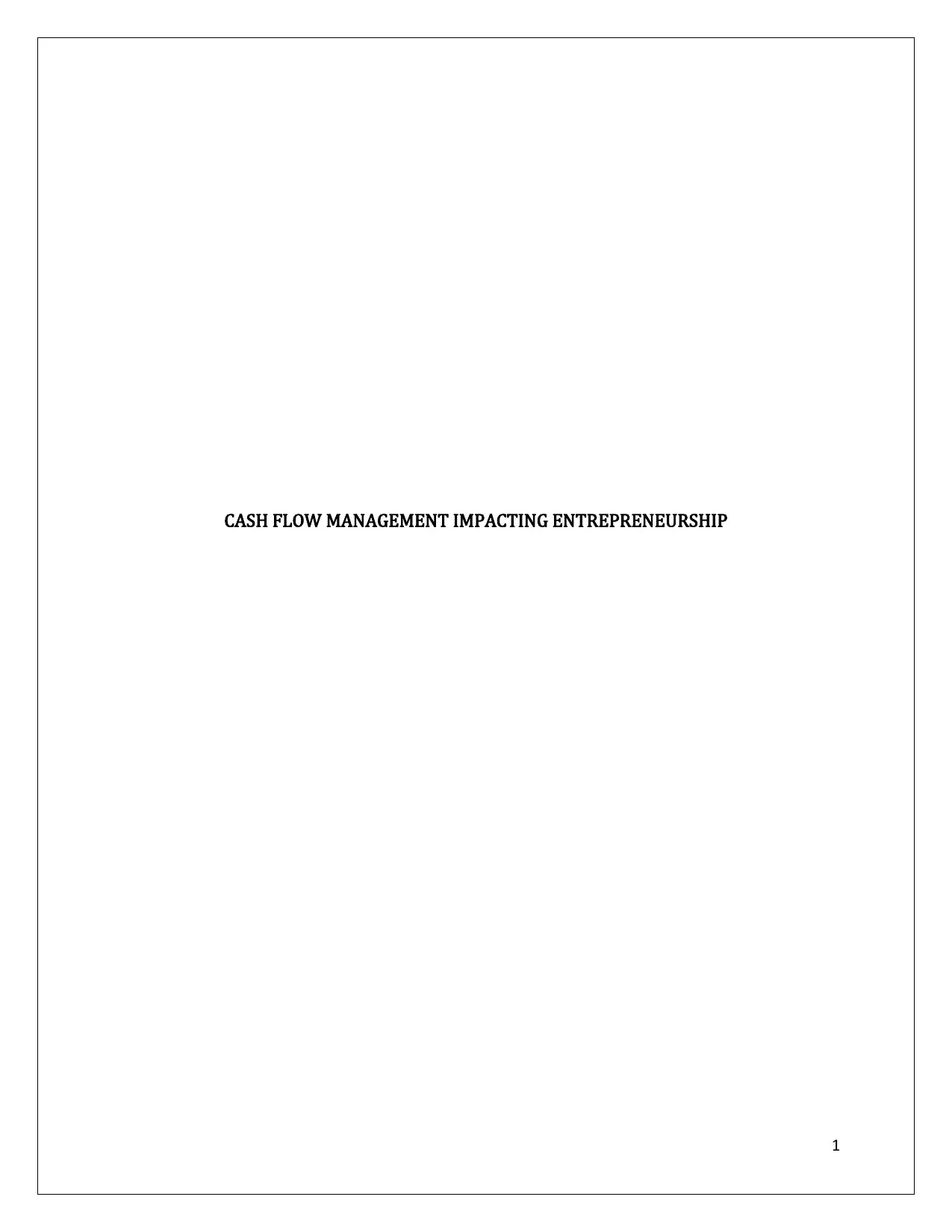
CASH FLOW MANAGEMENT IMPACTING ENTREPRENEURSHIP
1
1
Paraphrase This Document
Need a fresh take? Get an instant paraphrase of this document with our AI Paraphraser
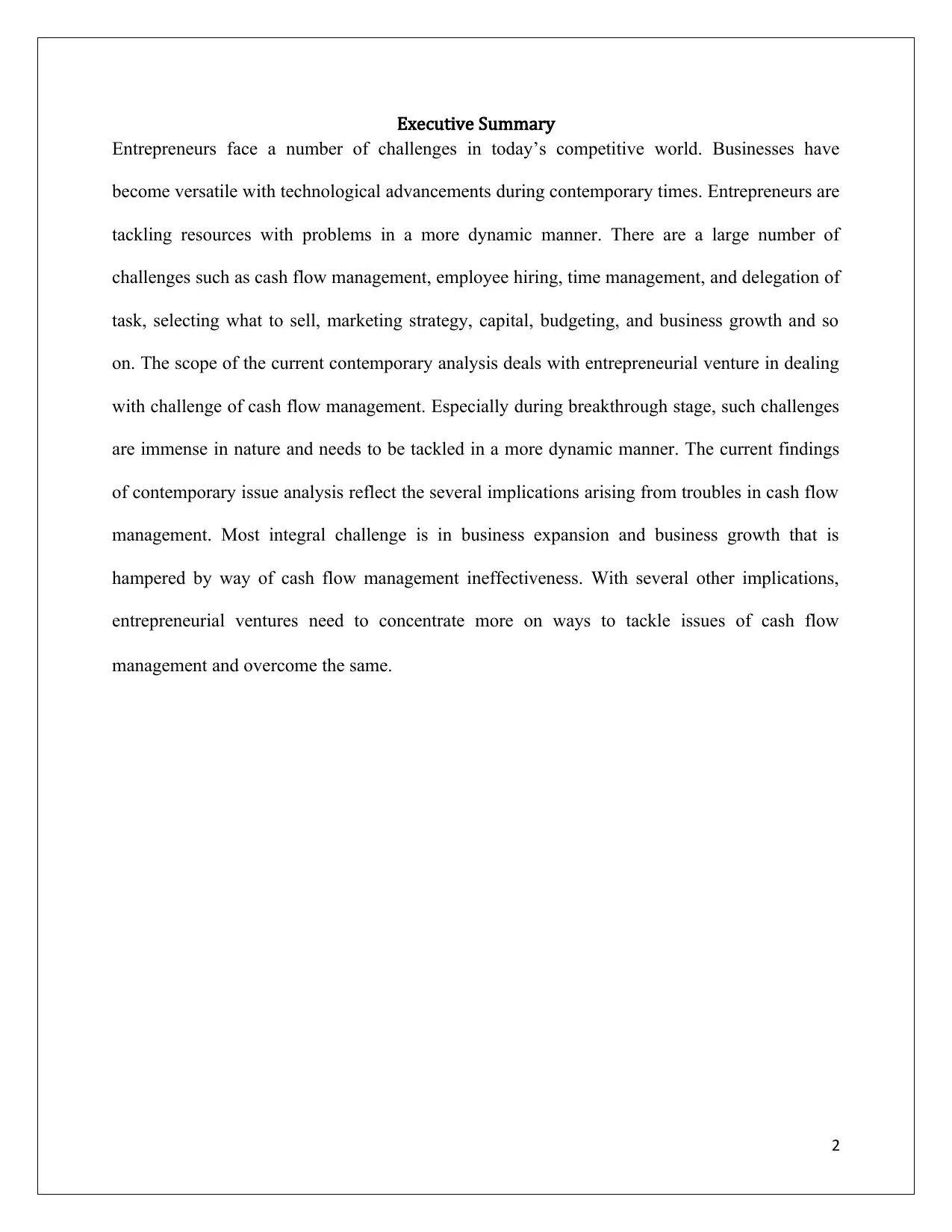
Executive Summary
Entrepreneurs face a number of challenges in today’s competitive world. Businesses have
become versatile with technological advancements during contemporary times. Entrepreneurs are
tackling resources with problems in a more dynamic manner. There are a large number of
challenges such as cash flow management, employee hiring, time management, and delegation of
task, selecting what to sell, marketing strategy, capital, budgeting, and business growth and so
on. The scope of the current contemporary analysis deals with entrepreneurial venture in dealing
with challenge of cash flow management. Especially during breakthrough stage, such challenges
are immense in nature and needs to be tackled in a more dynamic manner. The current findings
of contemporary issue analysis reflect the several implications arising from troubles in cash flow
management. Most integral challenge is in business expansion and business growth that is
hampered by way of cash flow management ineffectiveness. With several other implications,
entrepreneurial ventures need to concentrate more on ways to tackle issues of cash flow
management and overcome the same.
2
Entrepreneurs face a number of challenges in today’s competitive world. Businesses have
become versatile with technological advancements during contemporary times. Entrepreneurs are
tackling resources with problems in a more dynamic manner. There are a large number of
challenges such as cash flow management, employee hiring, time management, and delegation of
task, selecting what to sell, marketing strategy, capital, budgeting, and business growth and so
on. The scope of the current contemporary analysis deals with entrepreneurial venture in dealing
with challenge of cash flow management. Especially during breakthrough stage, such challenges
are immense in nature and needs to be tackled in a more dynamic manner. The current findings
of contemporary issue analysis reflect the several implications arising from troubles in cash flow
management. Most integral challenge is in business expansion and business growth that is
hampered by way of cash flow management ineffectiveness. With several other implications,
entrepreneurial ventures need to concentrate more on ways to tackle issues of cash flow
management and overcome the same.
2
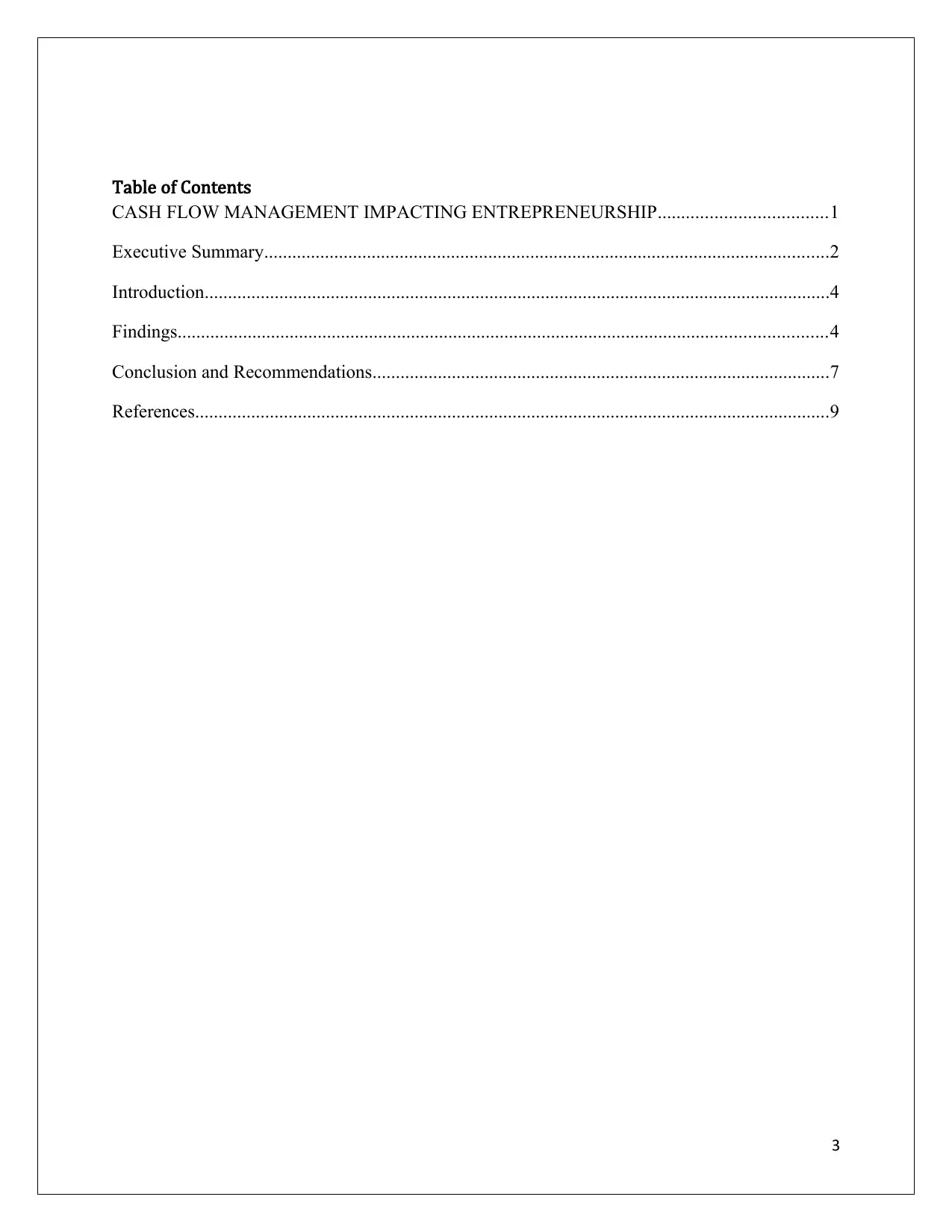
Table of Contents
CASH FLOW MANAGEMENT IMPACTING ENTREPRENEURSHIP....................................1
Executive Summary.........................................................................................................................2
Introduction......................................................................................................................................4
Findings...........................................................................................................................................4
Conclusion and Recommendations..................................................................................................7
References........................................................................................................................................9
3
CASH FLOW MANAGEMENT IMPACTING ENTREPRENEURSHIP....................................1
Executive Summary.........................................................................................................................2
Introduction......................................................................................................................................4
Findings...........................................................................................................................................4
Conclusion and Recommendations..................................................................................................7
References........................................................................................................................................9
3
⊘ This is a preview!⊘
Do you want full access?
Subscribe today to unlock all pages.

Trusted by 1+ million students worldwide
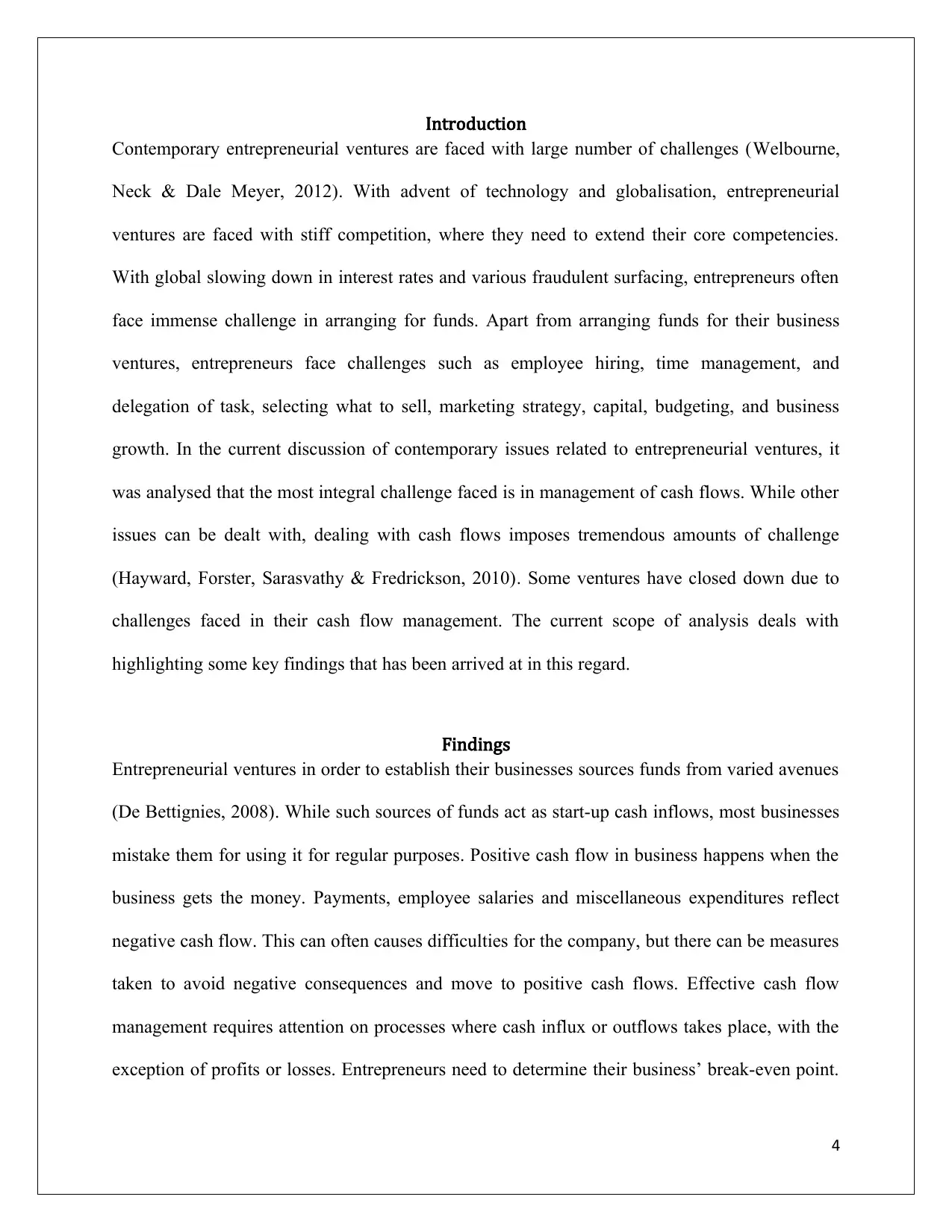
Introduction
Contemporary entrepreneurial ventures are faced with large number of challenges (Welbourne,
Neck & Dale Meyer, 2012). With advent of technology and globalisation, entrepreneurial
ventures are faced with stiff competition, where they need to extend their core competencies.
With global slowing down in interest rates and various fraudulent surfacing, entrepreneurs often
face immense challenge in arranging for funds. Apart from arranging funds for their business
ventures, entrepreneurs face challenges such as employee hiring, time management, and
delegation of task, selecting what to sell, marketing strategy, capital, budgeting, and business
growth. In the current discussion of contemporary issues related to entrepreneurial ventures, it
was analysed that the most integral challenge faced is in management of cash flows. While other
issues can be dealt with, dealing with cash flows imposes tremendous amounts of challenge
(Hayward, Forster, Sarasvathy & Fredrickson, 2010). Some ventures have closed down due to
challenges faced in their cash flow management. The current scope of analysis deals with
highlighting some key findings that has been arrived at in this regard.
Findings
Entrepreneurial ventures in order to establish their businesses sources funds from varied avenues
(De Bettignies, 2008). While such sources of funds act as start-up cash inflows, most businesses
mistake them for using it for regular purposes. Positive cash flow in business happens when the
business gets the money. Payments, employee salaries and miscellaneous expenditures reflect
negative cash flow. This can often causes difficulties for the company, but there can be measures
taken to avoid negative consequences and move to positive cash flows. Effective cash flow
management requires attention on processes where cash influx or outflows takes place, with the
exception of profits or losses. Entrepreneurs need to determine their business’ break-even point.
4
Contemporary entrepreneurial ventures are faced with large number of challenges (Welbourne,
Neck & Dale Meyer, 2012). With advent of technology and globalisation, entrepreneurial
ventures are faced with stiff competition, where they need to extend their core competencies.
With global slowing down in interest rates and various fraudulent surfacing, entrepreneurs often
face immense challenge in arranging for funds. Apart from arranging funds for their business
ventures, entrepreneurs face challenges such as employee hiring, time management, and
delegation of task, selecting what to sell, marketing strategy, capital, budgeting, and business
growth. In the current discussion of contemporary issues related to entrepreneurial ventures, it
was analysed that the most integral challenge faced is in management of cash flows. While other
issues can be dealt with, dealing with cash flows imposes tremendous amounts of challenge
(Hayward, Forster, Sarasvathy & Fredrickson, 2010). Some ventures have closed down due to
challenges faced in their cash flow management. The current scope of analysis deals with
highlighting some key findings that has been arrived at in this regard.
Findings
Entrepreneurial ventures in order to establish their businesses sources funds from varied avenues
(De Bettignies, 2008). While such sources of funds act as start-up cash inflows, most businesses
mistake them for using it for regular purposes. Positive cash flow in business happens when the
business gets the money. Payments, employee salaries and miscellaneous expenditures reflect
negative cash flow. This can often causes difficulties for the company, but there can be measures
taken to avoid negative consequences and move to positive cash flows. Effective cash flow
management requires attention on processes where cash influx or outflows takes place, with the
exception of profits or losses. Entrepreneurs need to determine their business’ break-even point.
4
Paraphrase This Document
Need a fresh take? Get an instant paraphrase of this document with our AI Paraphraser

One needs to know when a company is profitable because it does not influence cash flow, but it
has a particular purpose and a clearly predict the impending flow. Negative income has serious
consequences on the cash flows. The first step in cash flow management is to find the needs of
the business according to the needs of your company. The auditor, financial manager and
accountant can help in optimizing and eliminate challenges effectively over time. It is important
to start measuring the types of strategies to be adopted to manage cash flows in businesses.
Financials such as financing, like a credit line, can be used to speed up transfers or prevent
interest unrest. Many banks provide credit cards to suppliers or small entrepreneurs. Large
amounts of money, such as equipment and installations, should generally be financed with a
longer debt instrument. Assessing the use of viable financial instrument for particular type of
transaction to take place can enable better cash flow management. In case the venture does not
have any plans for financing then there might be challenges related to cash flow and suddenly
negativity might be reflected (Kaplan & Warren, 2009). The business venture needs to
continuously evaluate the available resources that are available within the organisation to ensure
no unused stocks is lying ideal, as that might block working capital. Entrepreneurial ventures
need to aim at reducing blocking of as much as working capital as possible, this will in turn
reduce its expenditures on interest rates and increase profitability. Poor, old and unused
resources use storage and significant capital that can be more profitable.
Manage payments the main strategy for cash flow management to keep a track on finances.
Voluntary resources or extended payments and discounts, need to be regularly accounted for
within entrepreneurial ventures. Another important cash flow strategy is being fast as possible.
This can be done in several ways by making contracts with customers who pay fast and reducing
number of debtors (Onetti, Zucchella, Jones & McDougall-Covin, 2012). Businesses need to
5
has a particular purpose and a clearly predict the impending flow. Negative income has serious
consequences on the cash flows. The first step in cash flow management is to find the needs of
the business according to the needs of your company. The auditor, financial manager and
accountant can help in optimizing and eliminate challenges effectively over time. It is important
to start measuring the types of strategies to be adopted to manage cash flows in businesses.
Financials such as financing, like a credit line, can be used to speed up transfers or prevent
interest unrest. Many banks provide credit cards to suppliers or small entrepreneurs. Large
amounts of money, such as equipment and installations, should generally be financed with a
longer debt instrument. Assessing the use of viable financial instrument for particular type of
transaction to take place can enable better cash flow management. In case the venture does not
have any plans for financing then there might be challenges related to cash flow and suddenly
negativity might be reflected (Kaplan & Warren, 2009). The business venture needs to
continuously evaluate the available resources that are available within the organisation to ensure
no unused stocks is lying ideal, as that might block working capital. Entrepreneurial ventures
need to aim at reducing blocking of as much as working capital as possible, this will in turn
reduce its expenditures on interest rates and increase profitability. Poor, old and unused
resources use storage and significant capital that can be more profitable.
Manage payments the main strategy for cash flow management to keep a track on finances.
Voluntary resources or extended payments and discounts, need to be regularly accounted for
within entrepreneurial ventures. Another important cash flow strategy is being fast as possible.
This can be done in several ways by making contracts with customers who pay fast and reducing
number of debtors (Onetti, Zucchella, Jones & McDougall-Covin, 2012). Businesses need to
5
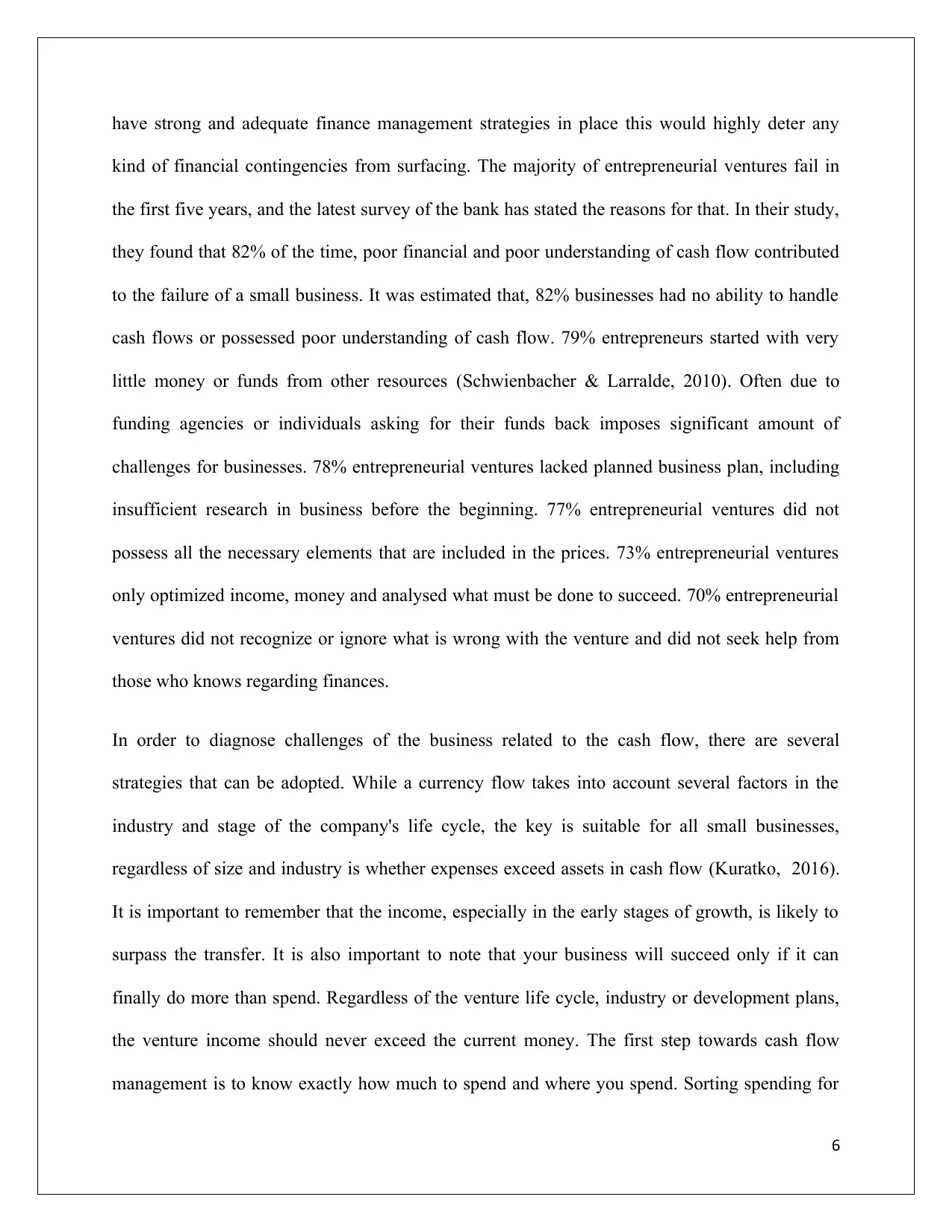
have strong and adequate finance management strategies in place this would highly deter any
kind of financial contingencies from surfacing. The majority of entrepreneurial ventures fail in
the first five years, and the latest survey of the bank has stated the reasons for that. In their study,
they found that 82% of the time, poor financial and poor understanding of cash flow contributed
to the failure of a small business. It was estimated that, 82% businesses had no ability to handle
cash flows or possessed poor understanding of cash flow. 79% entrepreneurs started with very
little money or funds from other resources (Schwienbacher & Larralde, 2010). Often due to
funding agencies or individuals asking for their funds back imposes significant amount of
challenges for businesses. 78% entrepreneurial ventures lacked planned business plan, including
insufficient research in business before the beginning. 77% entrepreneurial ventures did not
possess all the necessary elements that are included in the prices. 73% entrepreneurial ventures
only optimized income, money and analysed what must be done to succeed. 70% entrepreneurial
ventures did not recognize or ignore what is wrong with the venture and did not seek help from
those who knows regarding finances.
In order to diagnose challenges of the business related to the cash flow, there are several
strategies that can be adopted. While a currency flow takes into account several factors in the
industry and stage of the company's life cycle, the key is suitable for all small businesses,
regardless of size and industry is whether expenses exceed assets in cash flow (Kuratko, 2016).
It is important to remember that the income, especially in the early stages of growth, is likely to
surpass the transfer. It is also important to note that your business will succeed only if it can
finally do more than spend. Regardless of the venture life cycle, industry or development plans,
the venture income should never exceed the current money. The first step towards cash flow
management is to know exactly how much to spend and where you spend. Sorting spending for
6
kind of financial contingencies from surfacing. The majority of entrepreneurial ventures fail in
the first five years, and the latest survey of the bank has stated the reasons for that. In their study,
they found that 82% of the time, poor financial and poor understanding of cash flow contributed
to the failure of a small business. It was estimated that, 82% businesses had no ability to handle
cash flows or possessed poor understanding of cash flow. 79% entrepreneurs started with very
little money or funds from other resources (Schwienbacher & Larralde, 2010). Often due to
funding agencies or individuals asking for their funds back imposes significant amount of
challenges for businesses. 78% entrepreneurial ventures lacked planned business plan, including
insufficient research in business before the beginning. 77% entrepreneurial ventures did not
possess all the necessary elements that are included in the prices. 73% entrepreneurial ventures
only optimized income, money and analysed what must be done to succeed. 70% entrepreneurial
ventures did not recognize or ignore what is wrong with the venture and did not seek help from
those who knows regarding finances.
In order to diagnose challenges of the business related to the cash flow, there are several
strategies that can be adopted. While a currency flow takes into account several factors in the
industry and stage of the company's life cycle, the key is suitable for all small businesses,
regardless of size and industry is whether expenses exceed assets in cash flow (Kuratko, 2016).
It is important to remember that the income, especially in the early stages of growth, is likely to
surpass the transfer. It is also important to note that your business will succeed only if it can
finally do more than spend. Regardless of the venture life cycle, industry or development plans,
the venture income should never exceed the current money. The first step towards cash flow
management is to know exactly how much to spend and where you spend. Sorting spending for
6
⊘ This is a preview!⊘
Do you want full access?
Subscribe today to unlock all pages.

Trusted by 1+ million students worldwide
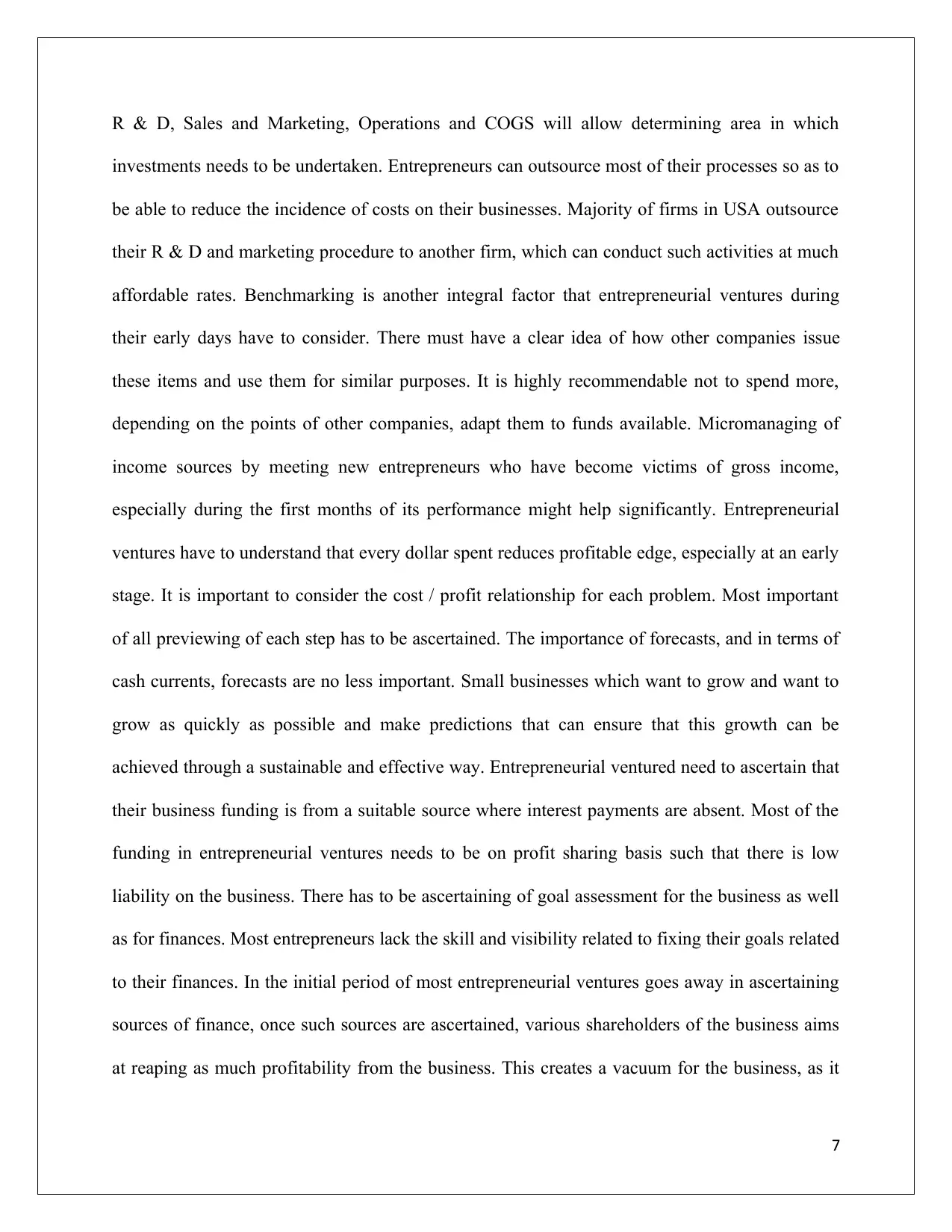
R & D, Sales and Marketing, Operations and COGS will allow determining area in which
investments needs to be undertaken. Entrepreneurs can outsource most of their processes so as to
be able to reduce the incidence of costs on their businesses. Majority of firms in USA outsource
their R & D and marketing procedure to another firm, which can conduct such activities at much
affordable rates. Benchmarking is another integral factor that entrepreneurial ventures during
their early days have to consider. There must have a clear idea of how other companies issue
these items and use them for similar purposes. It is highly recommendable not to spend more,
depending on the points of other companies, adapt them to funds available. Micromanaging of
income sources by meeting new entrepreneurs who have become victims of gross income,
especially during the first months of its performance might help significantly. Entrepreneurial
ventures have to understand that every dollar spent reduces profitable edge, especially at an early
stage. It is important to consider the cost / profit relationship for each problem. Most important
of all previewing of each step has to be ascertained. The importance of forecasts, and in terms of
cash currents, forecasts are no less important. Small businesses which want to grow and want to
grow as quickly as possible and make predictions that can ensure that this growth can be
achieved through a sustainable and effective way. Entrepreneurial ventured need to ascertain that
their business funding is from a suitable source where interest payments are absent. Most of the
funding in entrepreneurial ventures needs to be on profit sharing basis such that there is low
liability on the business. There has to be ascertaining of goal assessment for the business as well
as for finances. Most entrepreneurs lack the skill and visibility related to fixing their goals related
to their finances. In the initial period of most entrepreneurial ventures goes away in ascertaining
sources of finance, once such sources are ascertained, various shareholders of the business aims
at reaping as much profitability from the business. This creates a vacuum for the business, as it
7
investments needs to be undertaken. Entrepreneurs can outsource most of their processes so as to
be able to reduce the incidence of costs on their businesses. Majority of firms in USA outsource
their R & D and marketing procedure to another firm, which can conduct such activities at much
affordable rates. Benchmarking is another integral factor that entrepreneurial ventures during
their early days have to consider. There must have a clear idea of how other companies issue
these items and use them for similar purposes. It is highly recommendable not to spend more,
depending on the points of other companies, adapt them to funds available. Micromanaging of
income sources by meeting new entrepreneurs who have become victims of gross income,
especially during the first months of its performance might help significantly. Entrepreneurial
ventures have to understand that every dollar spent reduces profitable edge, especially at an early
stage. It is important to consider the cost / profit relationship for each problem. Most important
of all previewing of each step has to be ascertained. The importance of forecasts, and in terms of
cash currents, forecasts are no less important. Small businesses which want to grow and want to
grow as quickly as possible and make predictions that can ensure that this growth can be
achieved through a sustainable and effective way. Entrepreneurial ventured need to ascertain that
their business funding is from a suitable source where interest payments are absent. Most of the
funding in entrepreneurial ventures needs to be on profit sharing basis such that there is low
liability on the business. There has to be ascertaining of goal assessment for the business as well
as for finances. Most entrepreneurs lack the skill and visibility related to fixing their goals related
to their finances. In the initial period of most entrepreneurial ventures goes away in ascertaining
sources of finance, once such sources are ascertained, various shareholders of the business aims
at reaping as much profitability from the business. This creates a vacuum for the business, as it
7
Paraphrase This Document
Need a fresh take? Get an instant paraphrase of this document with our AI Paraphraser
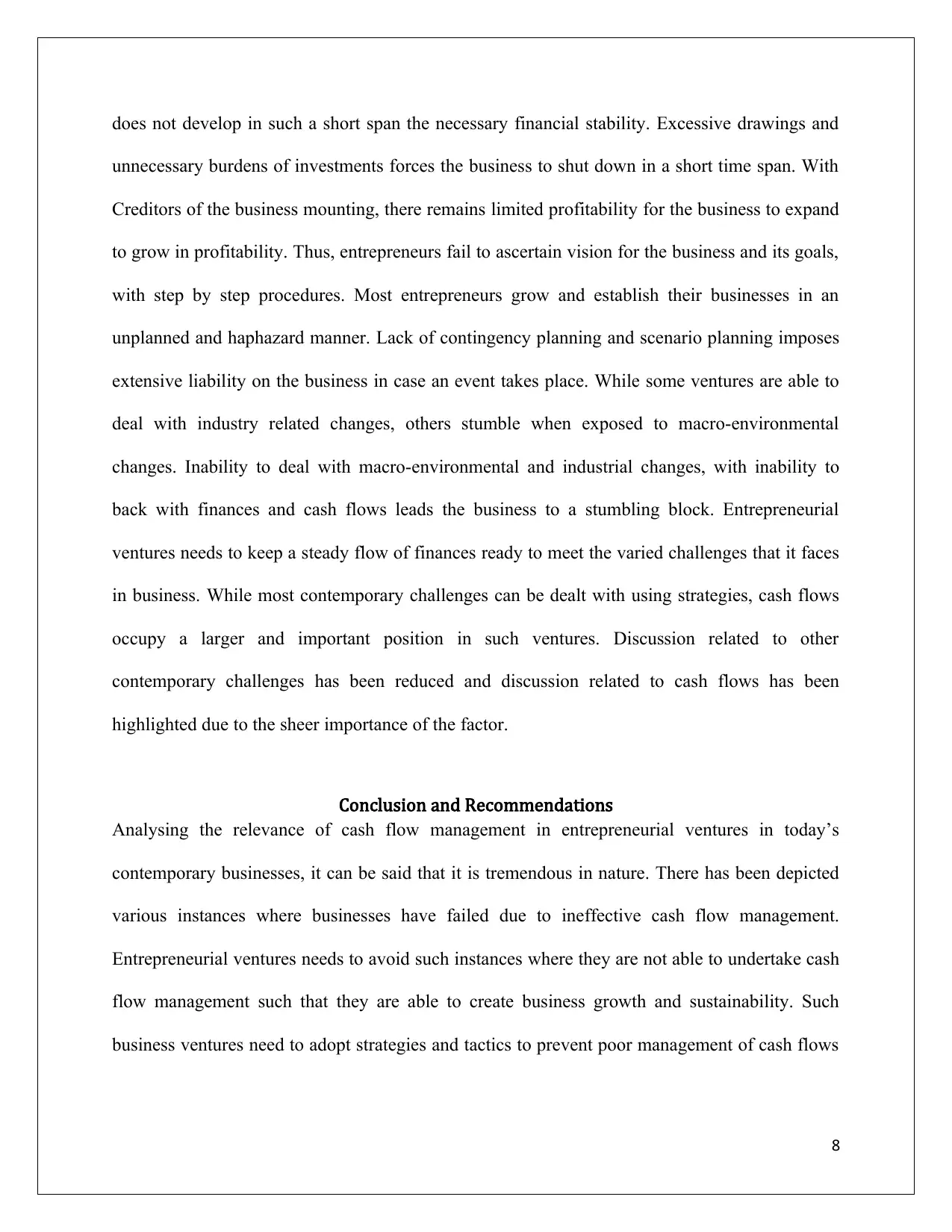
does not develop in such a short span the necessary financial stability. Excessive drawings and
unnecessary burdens of investments forces the business to shut down in a short time span. With
Creditors of the business mounting, there remains limited profitability for the business to expand
to grow in profitability. Thus, entrepreneurs fail to ascertain vision for the business and its goals,
with step by step procedures. Most entrepreneurs grow and establish their businesses in an
unplanned and haphazard manner. Lack of contingency planning and scenario planning imposes
extensive liability on the business in case an event takes place. While some ventures are able to
deal with industry related changes, others stumble when exposed to macro-environmental
changes. Inability to deal with macro-environmental and industrial changes, with inability to
back with finances and cash flows leads the business to a stumbling block. Entrepreneurial
ventures needs to keep a steady flow of finances ready to meet the varied challenges that it faces
in business. While most contemporary challenges can be dealt with using strategies, cash flows
occupy a larger and important position in such ventures. Discussion related to other
contemporary challenges has been reduced and discussion related to cash flows has been
highlighted due to the sheer importance of the factor.
Conclusion and Recommendations
Analysing the relevance of cash flow management in entrepreneurial ventures in today’s
contemporary businesses, it can be said that it is tremendous in nature. There has been depicted
various instances where businesses have failed due to ineffective cash flow management.
Entrepreneurial ventures needs to avoid such instances where they are not able to undertake cash
flow management such that they are able to create business growth and sustainability. Such
business ventures need to adopt strategies and tactics to prevent poor management of cash flows
8
unnecessary burdens of investments forces the business to shut down in a short time span. With
Creditors of the business mounting, there remains limited profitability for the business to expand
to grow in profitability. Thus, entrepreneurs fail to ascertain vision for the business and its goals,
with step by step procedures. Most entrepreneurs grow and establish their businesses in an
unplanned and haphazard manner. Lack of contingency planning and scenario planning imposes
extensive liability on the business in case an event takes place. While some ventures are able to
deal with industry related changes, others stumble when exposed to macro-environmental
changes. Inability to deal with macro-environmental and industrial changes, with inability to
back with finances and cash flows leads the business to a stumbling block. Entrepreneurial
ventures needs to keep a steady flow of finances ready to meet the varied challenges that it faces
in business. While most contemporary challenges can be dealt with using strategies, cash flows
occupy a larger and important position in such ventures. Discussion related to other
contemporary challenges has been reduced and discussion related to cash flows has been
highlighted due to the sheer importance of the factor.
Conclusion and Recommendations
Analysing the relevance of cash flow management in entrepreneurial ventures in today’s
contemporary businesses, it can be said that it is tremendous in nature. There has been depicted
various instances where businesses have failed due to ineffective cash flow management.
Entrepreneurial ventures needs to avoid such instances where they are not able to undertake cash
flow management such that they are able to create business growth and sustainability. Such
business ventures need to adopt strategies and tactics to prevent poor management of cash flows
8
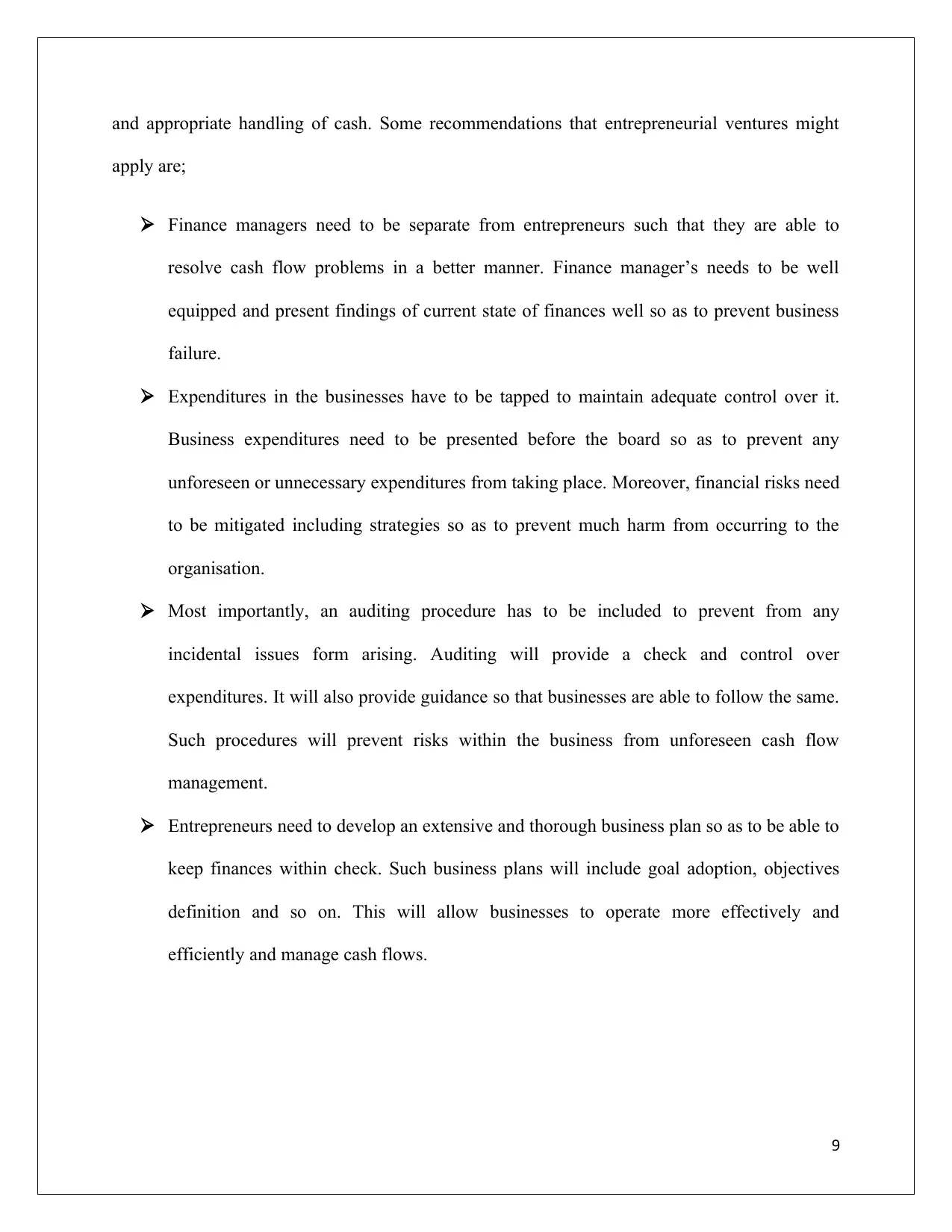
and appropriate handling of cash. Some recommendations that entrepreneurial ventures might
apply are;
Finance managers need to be separate from entrepreneurs such that they are able to
resolve cash flow problems in a better manner. Finance manager’s needs to be well
equipped and present findings of current state of finances well so as to prevent business
failure.
Expenditures in the businesses have to be tapped to maintain adequate control over it.
Business expenditures need to be presented before the board so as to prevent any
unforeseen or unnecessary expenditures from taking place. Moreover, financial risks need
to be mitigated including strategies so as to prevent much harm from occurring to the
organisation.
Most importantly, an auditing procedure has to be included to prevent from any
incidental issues form arising. Auditing will provide a check and control over
expenditures. It will also provide guidance so that businesses are able to follow the same.
Such procedures will prevent risks within the business from unforeseen cash flow
management.
Entrepreneurs need to develop an extensive and thorough business plan so as to be able to
keep finances within check. Such business plans will include goal adoption, objectives
definition and so on. This will allow businesses to operate more effectively and
efficiently and manage cash flows.
9
apply are;
Finance managers need to be separate from entrepreneurs such that they are able to
resolve cash flow problems in a better manner. Finance manager’s needs to be well
equipped and present findings of current state of finances well so as to prevent business
failure.
Expenditures in the businesses have to be tapped to maintain adequate control over it.
Business expenditures need to be presented before the board so as to prevent any
unforeseen or unnecessary expenditures from taking place. Moreover, financial risks need
to be mitigated including strategies so as to prevent much harm from occurring to the
organisation.
Most importantly, an auditing procedure has to be included to prevent from any
incidental issues form arising. Auditing will provide a check and control over
expenditures. It will also provide guidance so that businesses are able to follow the same.
Such procedures will prevent risks within the business from unforeseen cash flow
management.
Entrepreneurs need to develop an extensive and thorough business plan so as to be able to
keep finances within check. Such business plans will include goal adoption, objectives
definition and so on. This will allow businesses to operate more effectively and
efficiently and manage cash flows.
9
⊘ This is a preview!⊘
Do you want full access?
Subscribe today to unlock all pages.

Trusted by 1+ million students worldwide
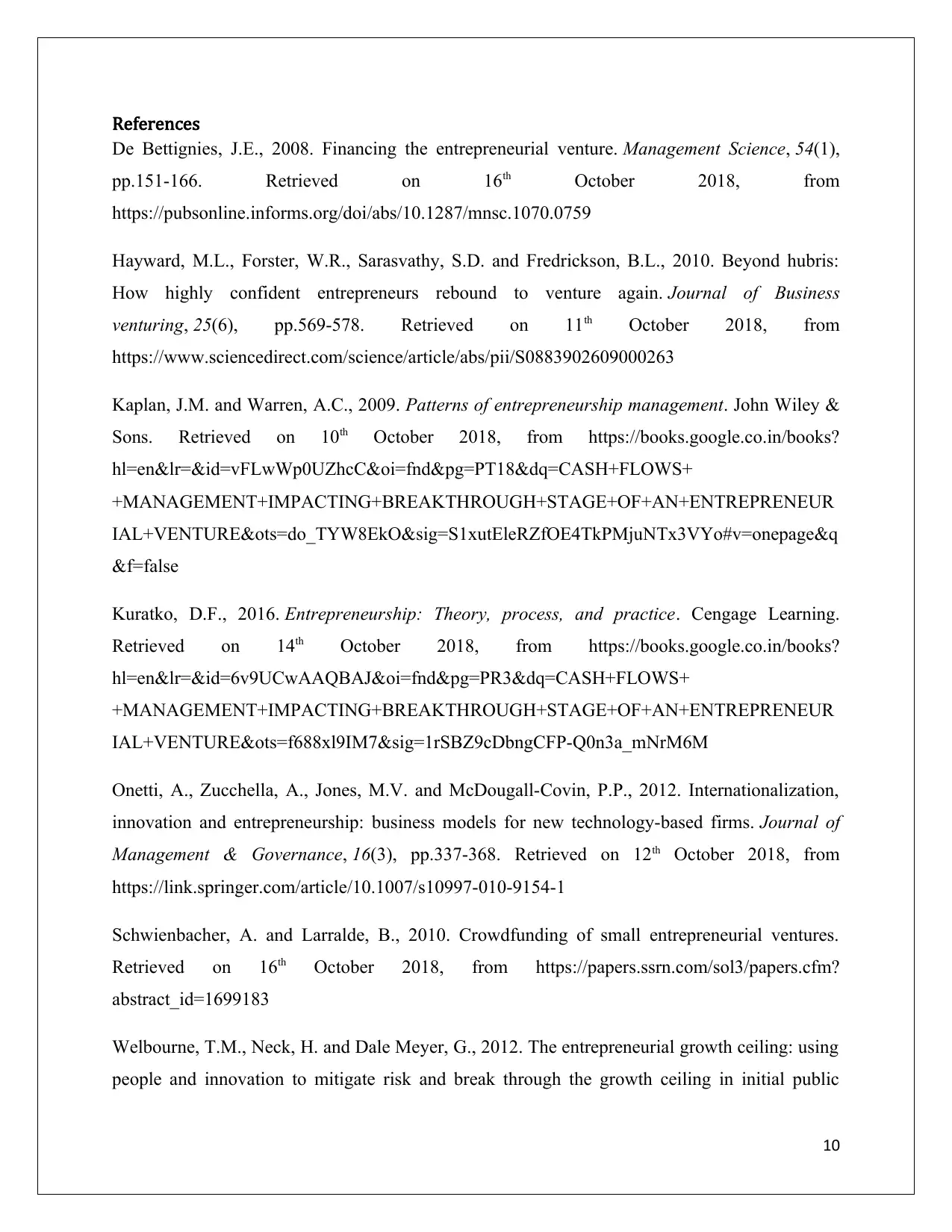
References
De Bettignies, J.E., 2008. Financing the entrepreneurial venture. Management Science, 54(1),
pp.151-166. Retrieved on 16th October 2018, from
https://pubsonline.informs.org/doi/abs/10.1287/mnsc.1070.0759
Hayward, M.L., Forster, W.R., Sarasvathy, S.D. and Fredrickson, B.L., 2010. Beyond hubris:
How highly confident entrepreneurs rebound to venture again. Journal of Business
venturing, 25(6), pp.569-578. Retrieved on 11th October 2018, from
https://www.sciencedirect.com/science/article/abs/pii/S0883902609000263
Kaplan, J.M. and Warren, A.C., 2009. Patterns of entrepreneurship management. John Wiley &
Sons. Retrieved on 10th October 2018, from https://books.google.co.in/books?
hl=en&lr=&id=vFLwWp0UZhcC&oi=fnd&pg=PT18&dq=CASH+FLOWS+
+MANAGEMENT+IMPACTING+BREAKTHROUGH+STAGE+OF+AN+ENTREPRENEUR
IAL+VENTURE&ots=do_TYW8EkO&sig=S1xutEleRZfOE4TkPMjuNTx3VYo#v=onepage&q
&f=false
Kuratko, D.F., 2016. Entrepreneurship: Theory, process, and practice. Cengage Learning.
Retrieved on 14th October 2018, from https://books.google.co.in/books?
hl=en&lr=&id=6v9UCwAAQBAJ&oi=fnd&pg=PR3&dq=CASH+FLOWS+
+MANAGEMENT+IMPACTING+BREAKTHROUGH+STAGE+OF+AN+ENTREPRENEUR
IAL+VENTURE&ots=f688xl9IM7&sig=1rSBZ9cDbngCFP-Q0n3a_mNrM6M
Onetti, A., Zucchella, A., Jones, M.V. and McDougall-Covin, P.P., 2012. Internationalization,
innovation and entrepreneurship: business models for new technology-based firms. Journal of
Management & Governance, 16(3), pp.337-368. Retrieved on 12th October 2018, from
https://link.springer.com/article/10.1007/s10997-010-9154-1
Schwienbacher, A. and Larralde, B., 2010. Crowdfunding of small entrepreneurial ventures.
Retrieved on 16th October 2018, from https://papers.ssrn.com/sol3/papers.cfm?
abstract_id=1699183
Welbourne, T.M., Neck, H. and Dale Meyer, G., 2012. The entrepreneurial growth ceiling: using
people and innovation to mitigate risk and break through the growth ceiling in initial public
10
De Bettignies, J.E., 2008. Financing the entrepreneurial venture. Management Science, 54(1),
pp.151-166. Retrieved on 16th October 2018, from
https://pubsonline.informs.org/doi/abs/10.1287/mnsc.1070.0759
Hayward, M.L., Forster, W.R., Sarasvathy, S.D. and Fredrickson, B.L., 2010. Beyond hubris:
How highly confident entrepreneurs rebound to venture again. Journal of Business
venturing, 25(6), pp.569-578. Retrieved on 11th October 2018, from
https://www.sciencedirect.com/science/article/abs/pii/S0883902609000263
Kaplan, J.M. and Warren, A.C., 2009. Patterns of entrepreneurship management. John Wiley &
Sons. Retrieved on 10th October 2018, from https://books.google.co.in/books?
hl=en&lr=&id=vFLwWp0UZhcC&oi=fnd&pg=PT18&dq=CASH+FLOWS+
+MANAGEMENT+IMPACTING+BREAKTHROUGH+STAGE+OF+AN+ENTREPRENEUR
IAL+VENTURE&ots=do_TYW8EkO&sig=S1xutEleRZfOE4TkPMjuNTx3VYo#v=onepage&q
&f=false
Kuratko, D.F., 2016. Entrepreneurship: Theory, process, and practice. Cengage Learning.
Retrieved on 14th October 2018, from https://books.google.co.in/books?
hl=en&lr=&id=6v9UCwAAQBAJ&oi=fnd&pg=PR3&dq=CASH+FLOWS+
+MANAGEMENT+IMPACTING+BREAKTHROUGH+STAGE+OF+AN+ENTREPRENEUR
IAL+VENTURE&ots=f688xl9IM7&sig=1rSBZ9cDbngCFP-Q0n3a_mNrM6M
Onetti, A., Zucchella, A., Jones, M.V. and McDougall-Covin, P.P., 2012. Internationalization,
innovation and entrepreneurship: business models for new technology-based firms. Journal of
Management & Governance, 16(3), pp.337-368. Retrieved on 12th October 2018, from
https://link.springer.com/article/10.1007/s10997-010-9154-1
Schwienbacher, A. and Larralde, B., 2010. Crowdfunding of small entrepreneurial ventures.
Retrieved on 16th October 2018, from https://papers.ssrn.com/sol3/papers.cfm?
abstract_id=1699183
Welbourne, T.M., Neck, H. and Dale Meyer, G., 2012. The entrepreneurial growth ceiling: using
people and innovation to mitigate risk and break through the growth ceiling in initial public
10
Paraphrase This Document
Need a fresh take? Get an instant paraphrase of this document with our AI Paraphraser

offerings. Management Decision, 50(5), pp.778-796. Retrieved on 15th October 2018, from
https://www.emeraldinsight.com/doi/abs/10.1108/00251741211227474
11
https://www.emeraldinsight.com/doi/abs/10.1108/00251741211227474
11

12
⊘ This is a preview!⊘
Do you want full access?
Subscribe today to unlock all pages.

Trusted by 1+ million students worldwide
1 out of 12
Related Documents
Your All-in-One AI-Powered Toolkit for Academic Success.
+13062052269
info@desklib.com
Available 24*7 on WhatsApp / Email
![[object Object]](/_next/static/media/star-bottom.7253800d.svg)
Unlock your academic potential
Copyright © 2020–2025 A2Z Services. All Rights Reserved. Developed and managed by ZUCOL.





